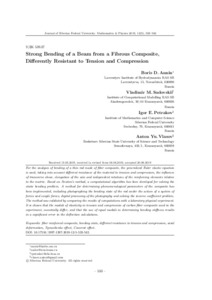Strong Bending of a Beam from a Fibrous Composite, Differently Resistant to Tension and Compression
Скачать файл:
URI (для ссылок/цитирований):
https://elib.sfu-kras.ru/handle/2311/125571Автор:
Annin, Boris D.
Sadovskii, Vladimir M.
Petrakov, Igor E.
Vlasov, Anton Yu.
Аннин, Борис Д.
Садовский, Владимир М.
Петраков, Игорь Е.
Власов, Антон Ю.
Дата:
2019-10Журнал:
Журнал Сибирского федерального университета. Математика и физика. Journal of Siberian Federal University. Mathematics & Physics; 2019 12 (5)Аннотация:
For the analysis of bending of a thin rod made of fiber composite, the generalized Euler elastic equation
is used, taking into account different resistance of the material to tension and compression, the influence
of transverse shear, elongation of the axis and independent rotations of the reinforcing elements relative
to the matrix. Based on Newton’s method, a computational algorithm has been developed for solving the
static bending problem. A method for determining phenomenological parameters of the composite has
been implemented, including photographing the bending state of the rod under the action of a system of
forces and couple forces, digital processing of the photography and solving the inverse coefficient problem.
The method was validated by comparing the results of computations with a laboratory physical experiment.
It is shown that the moduli of elasticity in tension and compression of carbon fiber composite used in the
experiment, essentially differ, and that the use of equal moduli in determining bending stiffness results
in a significant error in the deflection calculations К анализу изгиба тонкого стержня из волокнистого композита применяется обобщенное уравнение эластики Эйлера, учитывающее разное сопротивление материала растяжению и сжатию,
влияние поперечных сдвигов, удлинение вдоль оси и независимые повороты армирующих элементов относительно матрицы. На основе метода Ньютона разработан вычислительный алгоритм
для решения статической задачи изгиба. Реализована методика определения феноменологических
параметров композита, включающая в себя фотосъемку изгибного состояния стержня под действием системы сил и моментов сил, цифровую обработку фотографии и решение обратной коэффициентной задачи. Выполнена валидация методики путем сравнения результатов расчетов
с лабораторным физическим экспериментом. Показано, что для углепластика, применяемого в
эксперименте, модули упругости при растяжении и при сжатии существенно различаются, и
что использование равных модулей при определении жесткости на изгиб приводит к систематической ошибке в расчетах прогиба

